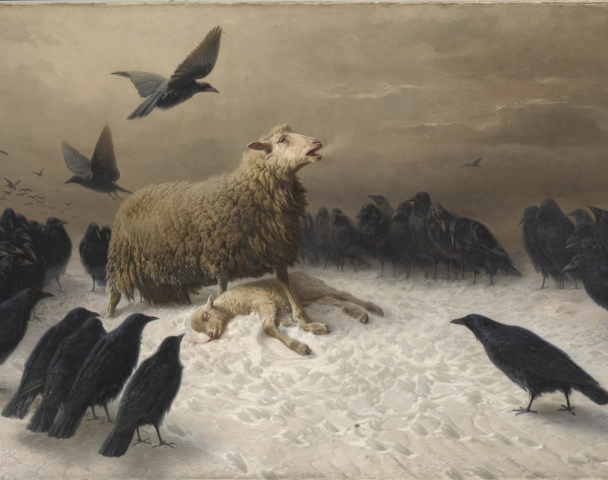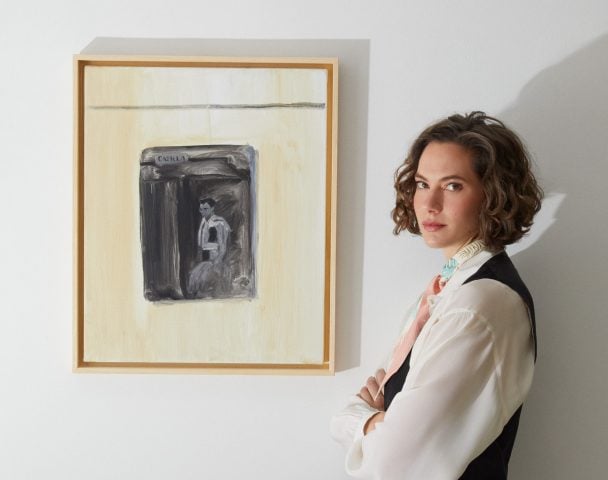Museums & Institutions
MoMA’s Director Loses Sleep Over Money, and Other Takeaways from an Insider-Heavy Conference
Talking Galleries convened over two days in a Manhattan skyscraper to debate the art world’s hottest issues.
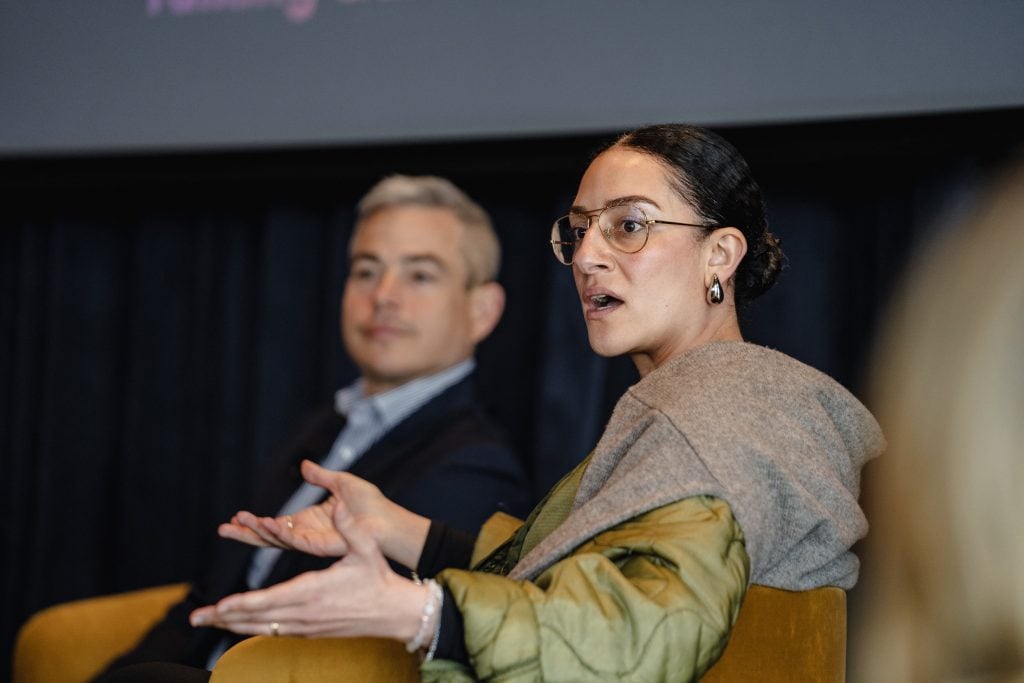
Even a solar eclipse couldn’t dissuade several dozen art world denizens from gathering for the second Talking Galleries New York conference on Monday and Tuesday, where heavyweight artists, collectors, curators, advisers, and dealers took to the stage to assess our fraught moment, with the art market dipping and the political and economic future highly uncertain. At $600 a ticket, of course, a little celestial event wasn’t going to keep them away.
Launched by cultural consultant, curator, and dealer Llucià Homs in Barcelona in 2011, Talking Galleries New York, under the leadership of Loring Randolph, took place 66 floors up in a West Midtown skyscraper that featured a deck with great visibility to the eclipse.

Talking Galleries attendees witness the eclipse. Courtesy Talking Galleries.
The convocation provided a setting where museum directors could welcome the coming demise of many institutions; an auction house executive could admit that houses’ statistics distort the market; and a dealer could say she’s lately been pondering mortality a lot.
These are some of the key takeaways from a lively two days.
1. Art Criticism and Journalism Need a Rethink
To kick things off, art critics and journalists hashed out the state of the art. Because so many publications cover the market, more people know about contemporary art, said journalist Mary Louise Schumacher, but because there’s not enough criticism, people are confused about the art itself. Though artists may not need critics, said Schumacher (who has a documentary on criticism, Out of the Picture, forthcoming), the community does, since critics do the field research for art history.
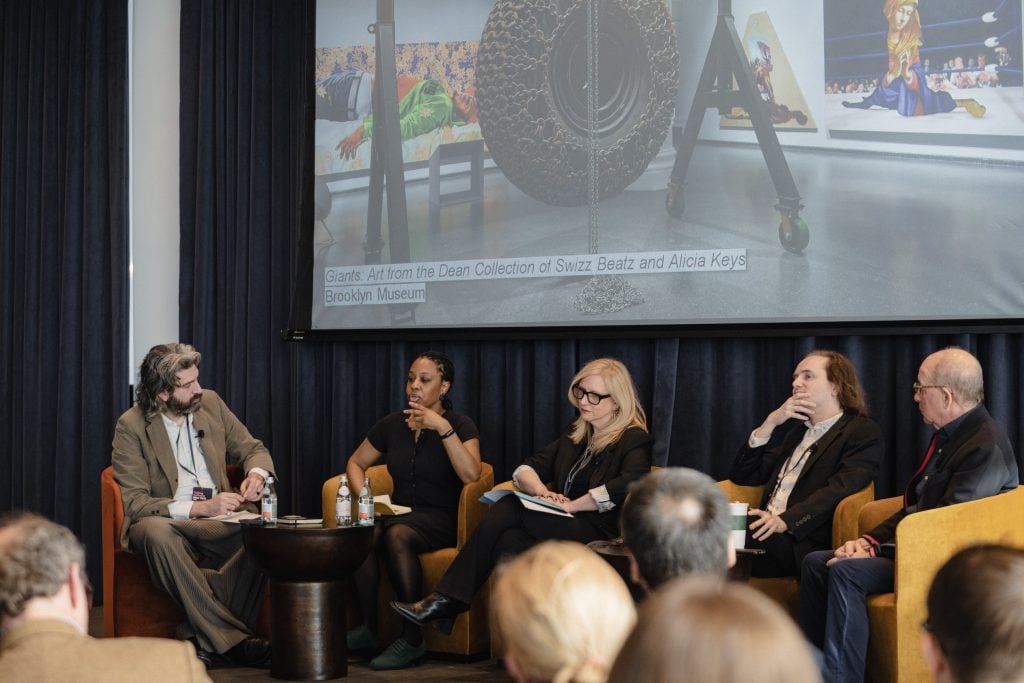
Matthew McLean, Danielle Jackson, Mary Louise Schumacher, Sean Tatol, and Jerry Saltz. Courtesy Talking Galleries.
To the burning question of whether art publishing can be made profitable, Schumacher suggested that philanthropic support from organizations like Press Forward and the Rubin Institute could do more; it was just about the only hopeful comment on the subject. (Teed up next, as it happens, was a talk by Conor O’Neil, director of the Chauncey and Marion Deering McCormick Foundation, which will soon be giving money to critics, journalists, and nonprofits that publish them, with a seven-figure sum to be doled out annually for some 14 years.)
The field overall, and criticism specifically, is overwhelmingly white, with power concentrated among a number of coastal white men, Schumacher observed. Critic Danielle Jackson, the panel’s sole Black participant, pointed out that when she gets invited to write, it’s often on Black women artists, which, she observed, points up a crisis of epistemology: who gets to be seen as an expert in what subjects?
2. Galleries Are Under Pressure
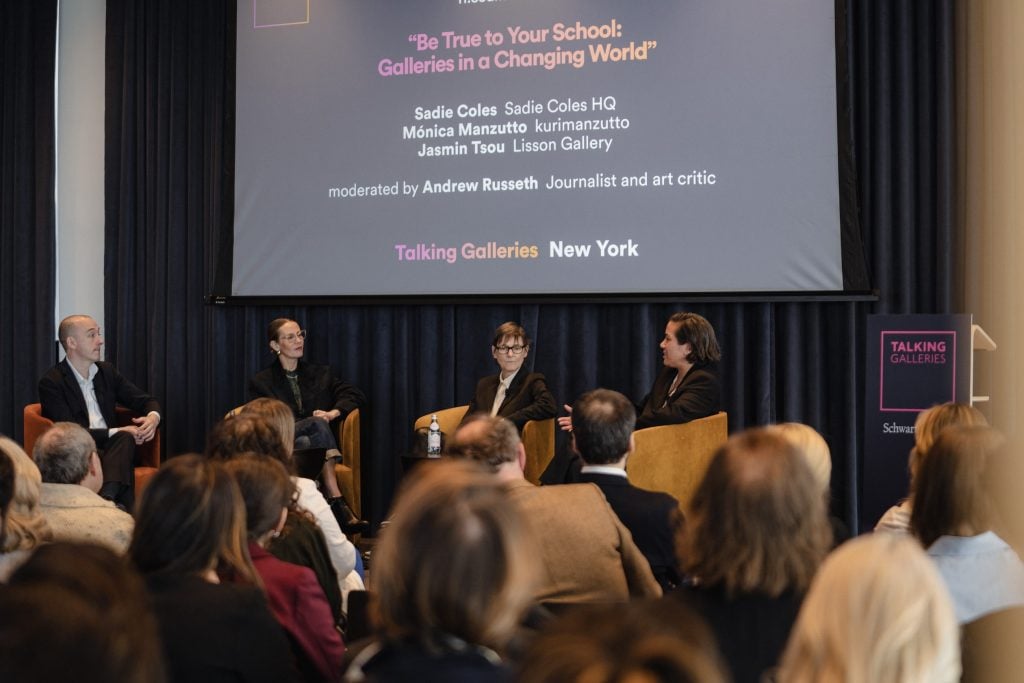
Andrew Russeth, Mónica Manzutto, Sadie Coles, and Jasmin Tsou. Courtesy Talking Galleries.
Dealers Sadie Coles (London), Mónica Manzutto (of kurimanzutto, Mexico City and New York) and Jasmin Tsou (formerly JTT, now Lisson) came together in an intimate and frank talk; all three have run, or do run, galleries with a maximum of two locations, and all have been models of integrity and a trailblazing spirit.
Asked by moderator and Artnet News Pro editor Andrew Russeth how things have changed over the years, Manzutto regretted the direction things have gone. Her gallery started very small, when there were no museums and no market in Mexico City, just a need of a gallery to show Mexican artists. She and co-founder José Kuri would like to return to the freedom they had then, she said.
Coles touted Tsou’s daring program, acknowledging the elephant on the stage, saying that Tsou supported artists to do whatever they wanted—the crazier the better—and that’s why JTT is no more.
On that subject, Tsou represented her move to the global Lisson Gallery as a celebratory occasion, even though many lamented JTT’s closure. “I helped others grieve,” she said. “There’s a big fear of death.” She’s been thinking about death a lot, she said.
Manzutto, too, said her gallery had sold lots of “weird things” over the years. “Now, I only sell paintings,” she said. “I hope I can go back.” (Yes, she repeated herself.)
In response to a question about how galleries professionalize, Tsou hilariously said that for her it involved a lot of time in the aisles at the Strand bookstore, reading books about running a business that she couldn’t afford to buy.
“I believe in art,” Tsou said. “That’s why I risked everything.”
But, though there’s an enormous wealth transfer to the Millennial generation to come, Tsou warned, they don’t feel the responsibility to support culture that their parents did, with stark implications for galleries.
3. Small Institutions Think Big
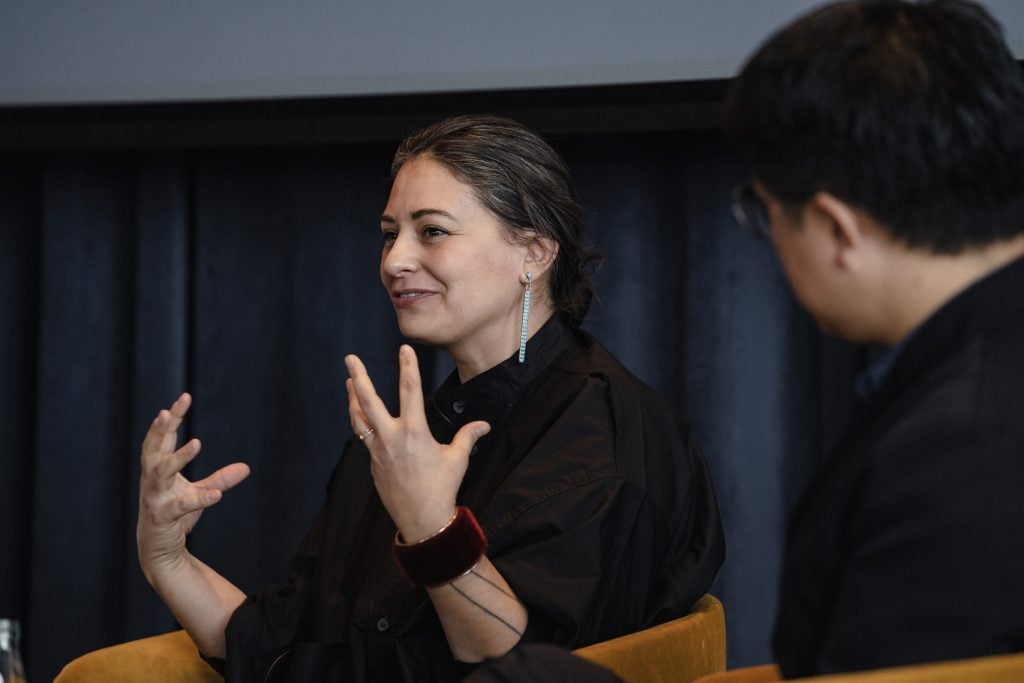
Candice Hopkins of Forge Projects. Courtesy Talking Galleries.
Can tiny, nimble institutions serve as the proving grounds for new ideas? Andria Hickey, head of programs at Shorefast and Fogo Island Arts in Newfoundland, along with Candice Hopkins, executive director and chief curator at the Forge Project, in New York’s Hudson Valley, and Billy Tang, executive director and curator of ParaSite, Hong Kong, addressed the question.
Hickey’s institution, on a tiny Canadian island, is finding out in one way. Its founding question is, how can you use arts to save a locale that’s been devastated by fishery mismanagement? The founder wanted to help the place thrive on a 100-year scale, said Hickey, with artist residencies serving as a Trojan horse to bring in people from all over the world. The founder’s mission, she added, is to change capitalism globally.
Hopkins, whose Forge Project has a lending collection of Native artists, pointed out that her institution has an Indigenous steering council, with members like Jeffrey Gibson and Sky Hopinka, that actually sits above the board (whereas, she said, committees are usually brought in to advise after decisions have already been made). She suggested a question for institutions: if you didn’t inherit the model you have, how would you do things differently?
Her organization’s mantra is that they move at the speed of trust. After pointing out that she is an uninvited guest of the Moh-He-Con-Nuck, today called the Stockbridge-Munsee Community, she said that some of the organization’s best programming has been for them alone, not for public consumption. Native cultures often define wealth by how much they can give away, she said; when the Forge Project asks for donations from visitors for, say, a tour, it in turn gives an equal amount to the Stockbridge-Munsee.
4. It Can Be Good When Prices Go Down, But They’re Not All Going Down
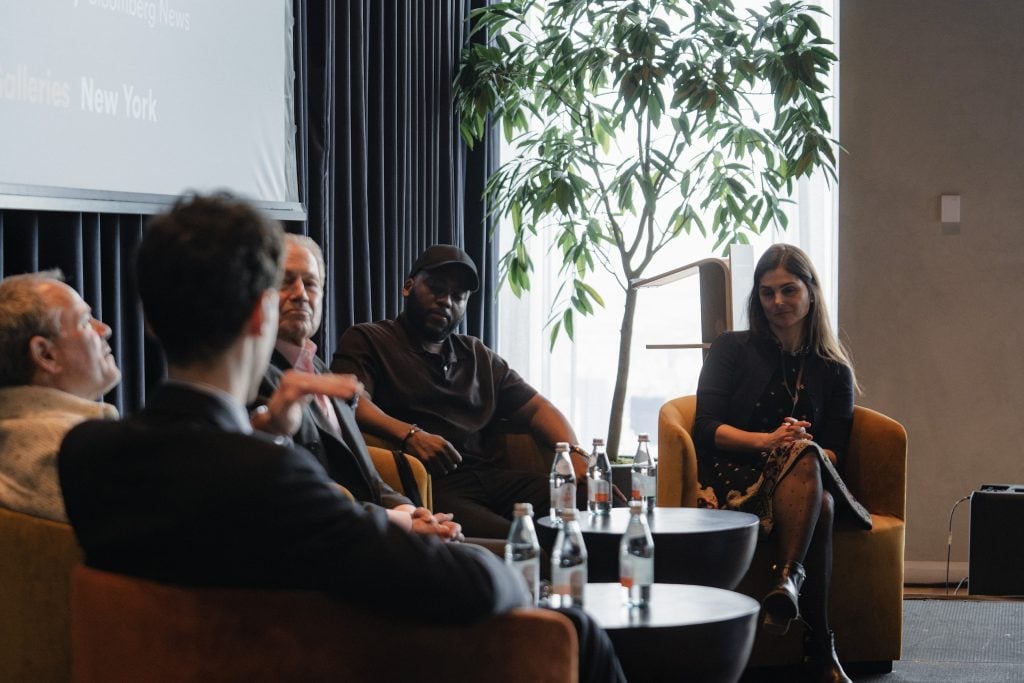
Allan Schwartzman, James Tarmy, J. Tomilson Hill, Gardy St. Fleur, and Brooke Lampley. Courtesy Talking Galleries.
A discussion of the art market with collector J. Tomilson Hill, Sotheby’s global chairman, Brooke Lampley, Sotheby’s head of global fine art, advisor Allan Schwartzman (who was a co-organizer of the conference), and advisor and collector Gardy St. Fleur touched on numerous hot issues.
Just because public auctions have slowed, Lampley counseled, don’t think that the market is done for: when public sales go down, private sales go up, and transactions are still happening behind the scenes, even for hundreds of millions of dollars. No wonder, Hill pointed out: whereas previously China was constantly sprouting museums, now the Middle East is doing the same.
When Bloomberg journalist James Tarmy, the moderator, asked what people will be thinking about in a year, Hill opined that it may well be the relationship between art and real estate, exemplified by Christopher Wool’s independently organized show of his work in a vacant downtown office space, at a moment when office vacancies have climbed to record heights.
In response to a question from ARTnews’s Karen Ho about what the media gets wrong, Lampley nodded to the truth of Katya Kazakina’s recent article pointing out that auction houses give a false impression of the health of the market when they exclude works withdrawn from auctions in the all-important “sell-through rate,” or the stated percentage of works that sell. You could hear eyebrows going up.
While participants might want markets to rise eternally, Schwartzman pointed out, there are artists whose markets have stopped in our post-frenzy moment, and there can be “nobility” in dropping their prices, he said, adding: “Sometimes you have to wipe the slate clean.”
5. Among Overbuilt Museums, Attrition Is Coming
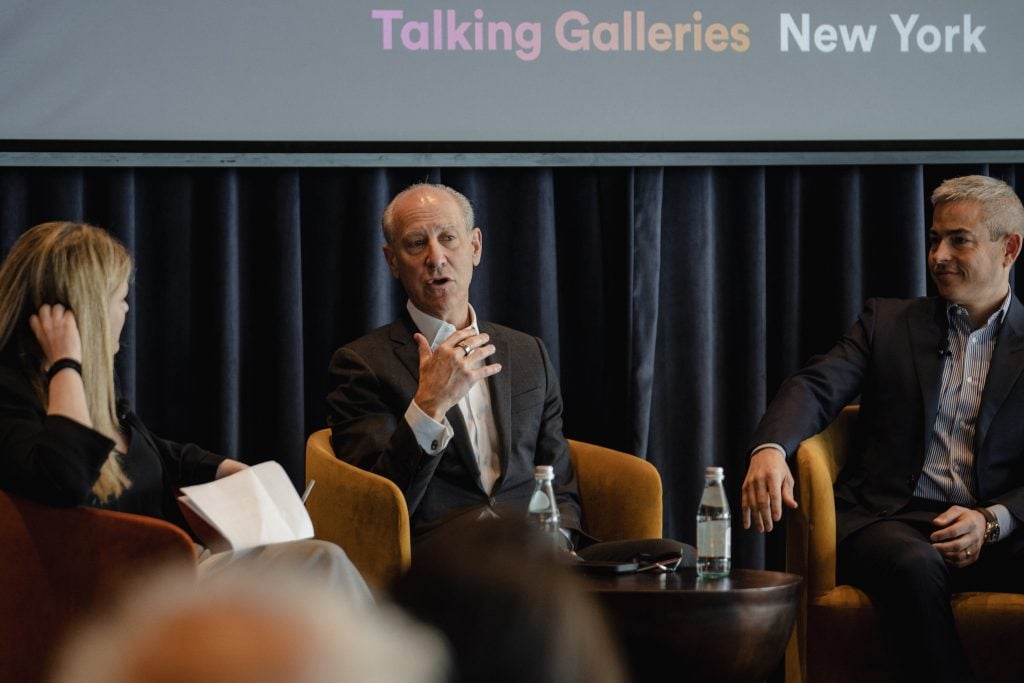
Julia Halperin, Glenn Lowry, and Pete Scantland. Courtesy Talking Galleries.
Yes, despite an enormous endowment, Glenn Lowry, the director of New York’s Museum of Modern Art, loses sleep over the institution’s finances, he said during a panel on the future of public institutions. Not only will museums have to come up with truly creative ways to generate revenue, the panelists agreed, they crucially have to build public, financial, and moral support. In order to do that, they should lighten up, take chances, and not be afraid of failure.
Pete Scantland, of Orange Barrel Media (a company that places digital displays in public places), put forth one approach his company came up with for the Pérez Art Museum Miami: a digital billboard on the museum’s grounds. Lowry pointed out that since retail and restaurants haven’t proven to be an El Dorado of funds, the museum has partnered with artists including Refik Anadol to put out NFTs, thereby earning seven-figure sums for the institution in a mission-friendly way. What’s more, as the pieces resell on the secondary market, royalties come to both museum and artist.
Deana Haggag, a program officer at the Mellon Foundation, chimed in that the traditional funding model for museums is unsustainable. Asked by moderator Julia Halperin whether there is a “yuck” line that museums shouldn’t cross, Haggag said she’s more concerned about museums not thinking creatively. On a hundred-year scale, she predicted, some museums will simply have to scale back or close. (Having worked at the now-defunct the Contemporary in Baltimore and the Underground Museum in Los Angeles, she said, she knows whereof she speaks.)
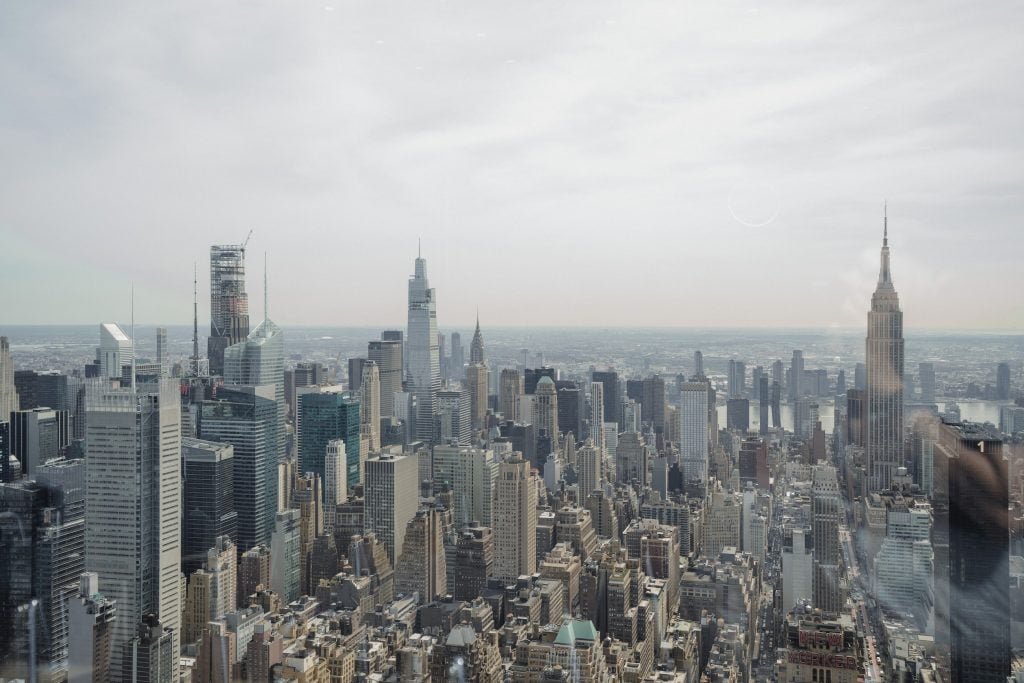
The view of New York from the 66th floor of the skyscraper where the Talking Galleries conference took place. Courtesy Talking Galleries.
“We have to get comfortable with failure,” Lowry said, echoing Haggag. It’s nonsense to assume, after a century of overbuilding, that all museums are here in perpetuity, he said. Just as galleries shutter, so will museums, and Haggag revealed that five percent of her granting portfolio is going to helping institutions to close. Lowry brought up MoMA’s union with PS1 as an example of the mergers and acquisitions model.
Innovation in the field, Lowry said, is coming as much these days from mega-galleries as from museums, which can no longer assume a right to a certain sanctity. Scantland pointed out that the Louvre and the Musée d’Orsay now both have billboards not on their property but on the buildings themselves. (And that’s the French!)
Lowry rehearsed what is, for him, a familiar argument: museum organizations’ restrictions on deaccessioning policies, which dictate that the proceeds of sales can go only to more acquisitions, are outdated and dangerous. Museum’s can’t collect indefinitely and are already bursting with stuff. They should be allowed to direct sale proceeds to programming, which is equally mission-critical, he insisted.
The panelists agreed that if museums don’t engage their publics in a deep and real way, they will be vulnerable when the same politicians who recently went after university administrators on the premise of anti-Semitism on campuses target the tax benefits that allow museums to survive.
Lowry hasn’t had a good night’s sleep in 25 years, he said, and he’s definitely deeply concerned about what happens if lawmakers come after those tax structures.
“I also lose sleep over this,” Haggag said. “Congress is coming for everybody else.”




